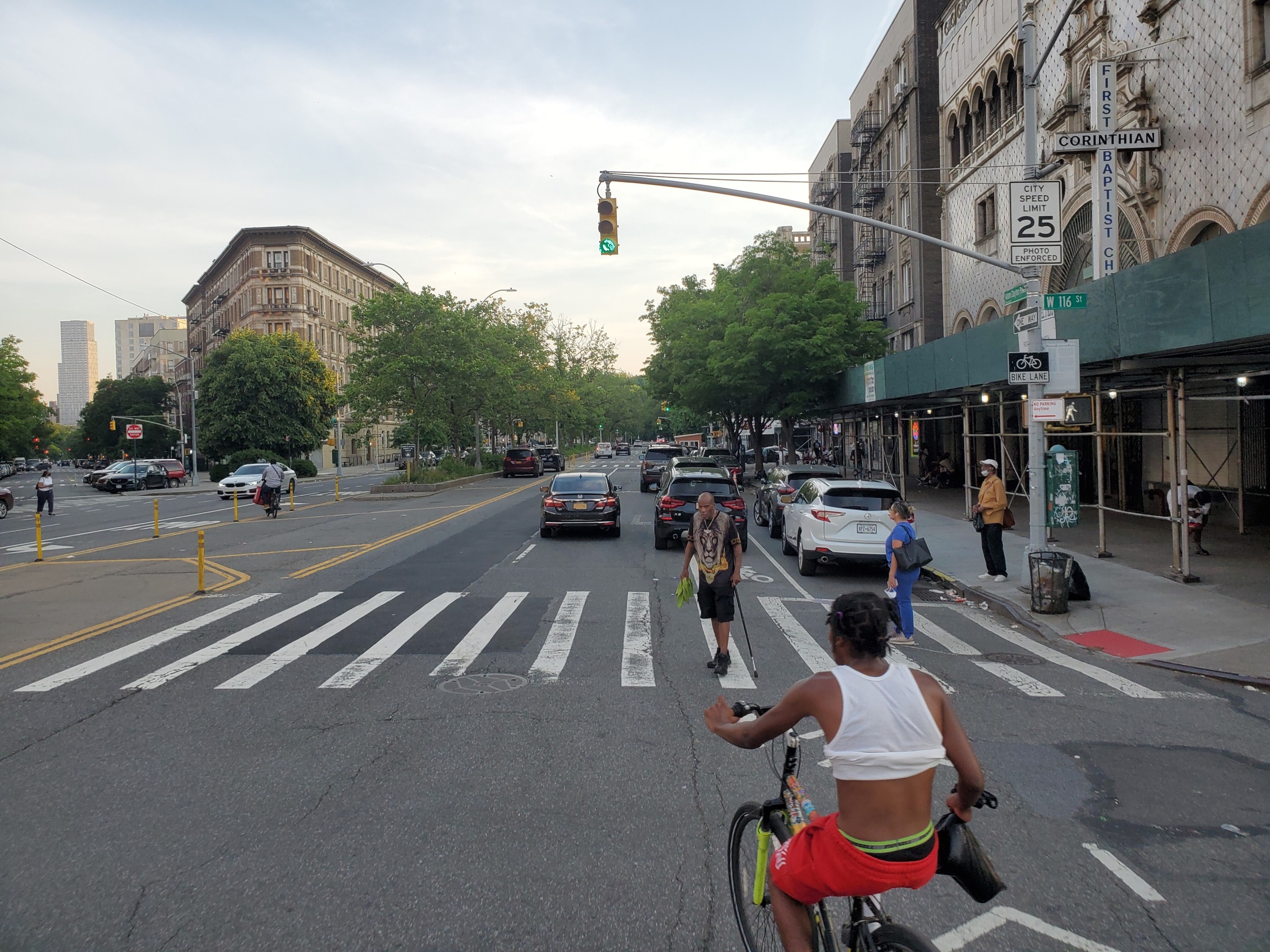Adam Clayton Powell Jr. Boulevard, the central Harlem avenue named for the area's illustrious longtime Congress member and also known as the "Boulevard of Dreams," was envisioned in the early decades of the 20th century, before mass motoring, as a parkway connecting walkers and bikers from Central Park to The Bronx.
Since then, however, the two-way, six-lane boulevard, which runs from Central Park North (110th Street) to its terminus at the Macombs Dam Bridge at 155th Street, has functioned more like an urban car sewer.
But times are changing: Now, more than a century after the proposed parkway became a car-choked artery, local activists from Transportation Alternatives's Bronx/Uptown Committee are seeking to remake this rich feature of Harlem's historical past into a bright part of Harlem’s future — with the creation along the boulevard of the Central Harlem Bikeway.
Our proposed bikeway would add a two-way protected bike lane along the median for the length of the boulevard, about 2.2 miles.
But our proposal isn't simply about history — or even safety. It's about justice.
Our neighborhood sorely needs safe bike infrastructure: 83.2 percent of the more than 109,000 residents living in this section of Harlem either bike, walk or take public transportation — much higher than the citywide average of 67 percent. Fewer than a quarter — 23 percent — of these residents own cars, and less than 8 percent use cars to commute daily. Yet cars, not people, dominate this historic avenue. Owing to a lack of political leadership, Community Board 10, which encompasses the Boulevard of Dreams, has no protected bike lanes.
It’s past time for Central Harlem's transportation infrastructure to catch up to the needs of residents. The neglect of safety along Adam Clayton Powell Jr. Boulevard has led this one avenue to account for more than a fifth of reported traffic injuries and 20 percent of traffic fatalities in the community board in the past five years, according to city data — an intolerable situation. In total, the boulevard has witnessed 2,126 crashes, with three pedestrians killed and 805 persons injured, including 145 cyclists, 173 pedestrians, and 487 motorists, during that period.
I support a protected bike lane on Adam Clayton Powell Blvd. from 110th to 155th streets, making a true #CentralHarlemBikeWay. #bikeNYC Can we count on your support? @NYCMayor @DickensforNY @senatorccleare @Kristin4Harlem @Kristin4Harlem
— Lilian (@LilirenoUS) August 19, 2022
@NYC_DOT https://t.co/wIcW2QhyEl
We need to muster the political will for a safer future — and we will.
We know that some folks think that traffic-safety investments such as sidewalks, protected bike lanes, and road diets serve as a conduit for gentrification and displacement. They're wrong. Higher rents from gentrification are a separate issue from street improvements and traffic safety. Indeed, the delay of traffic-safety improvements in Harlem has not stopped gentrification one iota — as anyone can see.
But those beliefs are not only false; they actually harm Black people.
False ideas, such as “Black people don’t bike” or “bike lanes are white lanes,” erase Black and other people of color from any consideration in discussions of traffic safety (not to mention, perpetuate pernicious stereotypes). Not only that — the lack of safety infrastructure in our neighborhoods leads directly to injuries and deaths!
The statistics are sobering: Black people and other people of color walking or biking America are at least twice and, in many cases, four times as likely, to be the victim of a traffic fatality as a white person — even though black people, on average, make fewer trips than white people, according to studies. Studies also have shown that drivers drive more aggressively around black people and other people of color.
In order to save lives, we must listen to the majority of community members, who walk, bike and use public transportation, and not the vocal defenders of motorists who drown out their voices. Pedestrian and cyclist safety should be a higher priority than parking. Harlem is not a parking lot. People live here!
Human lives — and especially, Black lives — matter more than a parking spot or saving an extra 30 seconds of driving.
The primary concern of government officials should be safety. Double parking and, in many cases, parking itself, blocks sight lines, causing motorists to hit pedestrians and micomobility users. Traffic-safety improvements should not have to wait for community board approval. The city, and our elected representatives, must invest in Harlem and Uptown Manhattan’s transportation infrastructure.
One important way is to reclaim the Boulevard of Dreams.
We're heartened by the support that our new Council Member, Kristen Richardson Jordan, has given our campaign. "Black people ride, too, and delivery workers deserve better. Protected bike lanes belong uptown," she told us.
Let's establish the Central Harlem Bikeway connecting Harlem and The Bronx to Central Park with a safe, protected bike lane — now.
Transportation Alternatives activist Chris Sanders (@SwiftySanders) lives in Harlem. You can sign the petition to create the Central Harlem Bikeway here.







